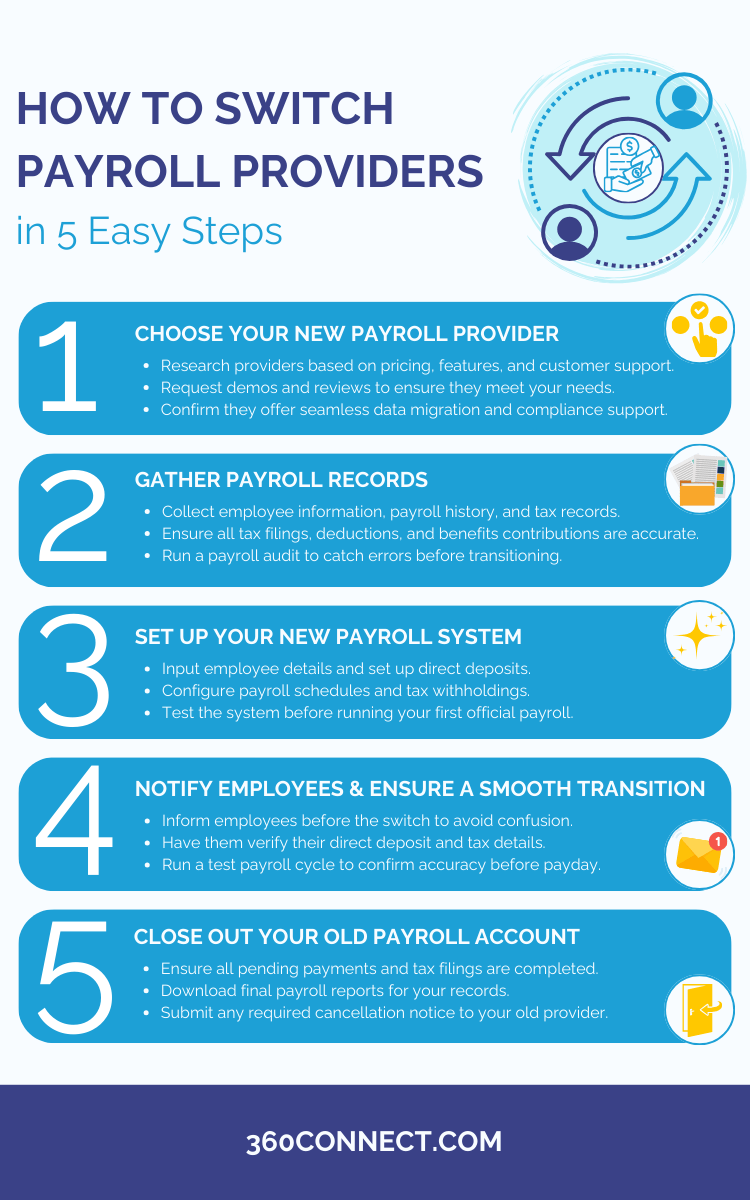Wondering how to switch payroll providers? You’re in the right place! Whether you’re frustrated with high fees, payroll errors, or poor customer service, making the switch doesn’t have to be a headache. With the right approach, you can transition smoothly and avoid payroll disruptions.
So, how do you switch payroll providers? We won’t waste your time with unnecessary fluff. This guide walks you through everything you need to know about switching payroll providers, the reasons, the process, and the best time to make the switch. Let’s get started.
What Are the Reasons to Switch Payroll Providers?
Yes, you already know you want to switch payroll providers. But before you move forward, it’s important to pinpoint the exact reasons. This will help you avoid the same issues with your next provider and ensure the switch is truly necessary. Here are some of the most common reasons businesses switch payroll providers:
- Hidden Fees & High Costs: If your provider has surprise fees or a pricing model that no longer makes sense for your business, it might be time to move on. Many payroll services lure you in with low starting rates, only to hike up fees later.
- Poor Customer Support: Payroll is too important to deal with slow or unhelpful customer service. If you’re constantly struggling to get help, switching providers can make your life easier.
- Payroll technology challenges affect 85% of businesses.
- Limited Features: Does your current payroll provider lack automation, direct deposit options, tax filing services, or integrations with your accounting software? If so, upgrading to a more feature-rich provider can save you time.
- Globally, 37% of businesses lack integration across all HR systems.
- Frequent Payroll Errors: Mistakes with tax filings, incorrect paychecks, and compliance issues can create major problems. If your provider frequently makes errors, it’s a serious red flag.
- Compliance & Tax Issues: If your current provider struggles with staying compliant or has ever caused you to incur tax penalties, you should consider switching immediately.
- Scalability Issues: As your business grows, you need a payroll system that can grow with you. Some providers work great for small businesses but don’t scale well as you add employees or expand to multiple locations.
If you’re experiencing one or more of these issues, switching payroll providers is probably the right move. But is the process as simple as it sounds?
Is Switching Payroll Providers Easy?
The short answer? It depends. The complexity of switching payroll providers comes down to timing, record-keeping, and coordination. While the process itself isn’t difficult, mistakes can lead to payroll disruptions, tax filing issues, and compliance risks.
However, with proper planning, the transition can be seamless. Most reputable payroll providers offer transition assistance, but it’s still crucial to understand the process and prepare accordingly. The next section outlines exactly how to switch payroll providers with minimal stress.
How to Switch Payroll Providers
It’s no secret that switching payroll providers can be challenging, so here’s how to do it step by step.

Step 1: Choose Your New Payroll Provider
Before making any changes, you need to carefully select your next payroll provider. Rushing this decision can lead to the same frustrations you’re experiencing now, so take time to compare features, pricing, customer support, and compliance capabilities.
Related: The 7 Best Payroll Providers for a Business
Start by identifying your payroll pain points. Was your last provider too expensive? Did they lack automation, leading to payroll errors? Was customer support unresponsive? Defining what went wrong will help you find a provider that actually solves those issues.
Next, compare payroll providers. Request demos, read user reviews, and ask about transition support. Some payroll services offer seamless onboarding, data migration, and compliance assistance, while others leave most of the work to you. If your business operates in multiple states, ensure your new provider can handle multi-state payroll processing.
Lastly, verify contract terms and cancellation policies. Some providers require a specific notice period before canceling services, and you don’t want unexpected fees or service disruptions. Once you’ve made your choice, confirm with your new provider that they will assist in the transition process before you notify your old provider.
Related: 10 Questions to Ask When Choosing A Payroll Service
Step 2: Gather Payroll Records & Reports
Once you have selected a new provider, you need to gather all essential payroll records for a smooth transition. Your new provider will require accurate data to ensure there are no disruptions to employee pay or tax compliance.
Start by collecting:
- Employee details – Names, addresses, Social Security numbers, tax withholding forms (W-4s or W-9s), and direct deposit details.
- Payroll history – Year-to-date earnings, tax withholdings, deductions, and bonuses for all employees.
- Tax filings & payment records – Copies of recent payroll tax filings and records of tax payments.
- Benefits & deductions – Any information on healthcare, retirement plans, or other employee deductions.
A payroll audit before switching providers is highly recommended. Review all employee classifications (W-2 vs. 1099), payroll tax deductions, and wage rates. Any errors should be corrected before transferring data to your new provider.
Be sure to back up all payroll records before making the switch. Some old providers may lock you out of the system once you cancel, and you need to ensure you have access to past pay records for tax purposes.
Step 3: Set Up Your New Payroll System
Now that you have your records in place, it’s time to configure your new payroll system. Your new provider will typically have an onboarding process, but you need to double-check every detail to ensure a smooth transition.
First, input employee data into the new system. Ensure names, Social Security numbers, tax withholdings, and direct deposit details are entered correctly. Mistakes here can lead to employees not getting paid or incorrect tax filings.
Next, set up payroll schedules. Choose whether you will pay employees weekly, biweekly, semi-monthly, or monthly. If your new provider offers automated payroll, take advantage of it to minimize manual work.
Then, integrate with your accounting software if needed. Many payroll providers sync with accounting platforms like QuickBooks or Xero, making it easier to track payroll expenses and tax deductions. If your previous provider was integrated, ensure the data transfer is complete and accurate before disconnecting the old system.
Finally, test the system before the first payroll run. Conduct a test payroll to confirm tax calculations, deductions, and direct deposits are functioning correctly. This ensures you can catch any errors before they affect real paychecks.
Step 4: Notify Employees & Ensure a Smooth Transition
Your employees need to be informed before the payroll switch happens. Sudden changes to payroll can lead to confusion, delayed payments, or errors, so clear communication is key.
Start by sending an email or hosting a short meeting explaining:
- Why you’re switching payroll providers (improving accuracy, better benefits, easier access to pay stubs, etc.).
- What employees need to do (update direct deposit info, verify tax withholdings, etc.).
- Any changes to payroll schedules or deductions.
Encourage employees to log into the new system (if applicable) to verify their information. They should check their direct deposit details, tax withholding selections, and deductions to avoid issues when the first paycheck is processed.
If your company offers employee benefits through payroll deductions, confirm that benefit contributions transfer over correctly. Any mistakes here could result in missed insurance payments or incorrect retirement contributions.
Lastly, run a small test payroll if possible. Some payroll providers allow you to process a dummy payroll run to verify accuracy before the first official paycheck goes out.
Step 5: Close Out Your Old Payroll Account
Once your new payroll system is fully operational, it’s time to officially close out your old payroll account. This ensures you’re not being double-billed and that your records remain intact.
Start by checking for outstanding payroll runs. Make sure all pending wages, reimbursements, or bonuses from your old provider have been paid. If any taxes are due from previous pay periods, confirm they have been filed and paid before deactivating the account.
Next, request final payroll reports from your old provider. These documents serve as proof of past payments and will be needed for tax season. Some payroll providers charge for historical reports after cancellation, so download everything you need in advance.
Finally, review your contract and cancellation policy. Some payroll providers require a formal written request to terminate services. If you’re under contract, check if there are early termination fees. If required, keep documentation of cancellation confirmations to prevent unexpected charges.
Once everything is confirmed, you can fully deactivate your old payroll provider and move forward with your new system.
When Is the Best Time to Switch Payroll Providers?
The best time to switch payroll providers is at the start of a new quarter or fiscal year. Why?
- Avoid Mid-Year Tax Filing Issues: Switching at the start of a new quarter or year makes tax reporting cleaner and avoids tax filing mistakes.
- Simpler Payroll Records Transfer: A clean break between payroll providers prevents data loss or duplicate reporting.
- Minimal Employee Disruption: Employees expect consistency in payroll. Switching between pay periods can cause confusion.
That said, if your current provider is making critical errors or overcharging you, switching as soon as possible might be necessary.
Final Thoughts
Switching payroll providers might seem like a hassle, but if you’re dealing with high costs, payroll errors, or poor service, it’s a move that can save you time, stress, and money in the long run. By following the right steps and switching at the right time, you can ensure a smooth transition with minimal disruptions.
Whether you’re looking for better customer support, lower costs, or more automation, there’s a payroll provider that fits your needs.
Get Payroll Quotes Now
Save time and compare the best payroll providers for your business. Get up to 5 free payroll quotes with 360Connect today!

